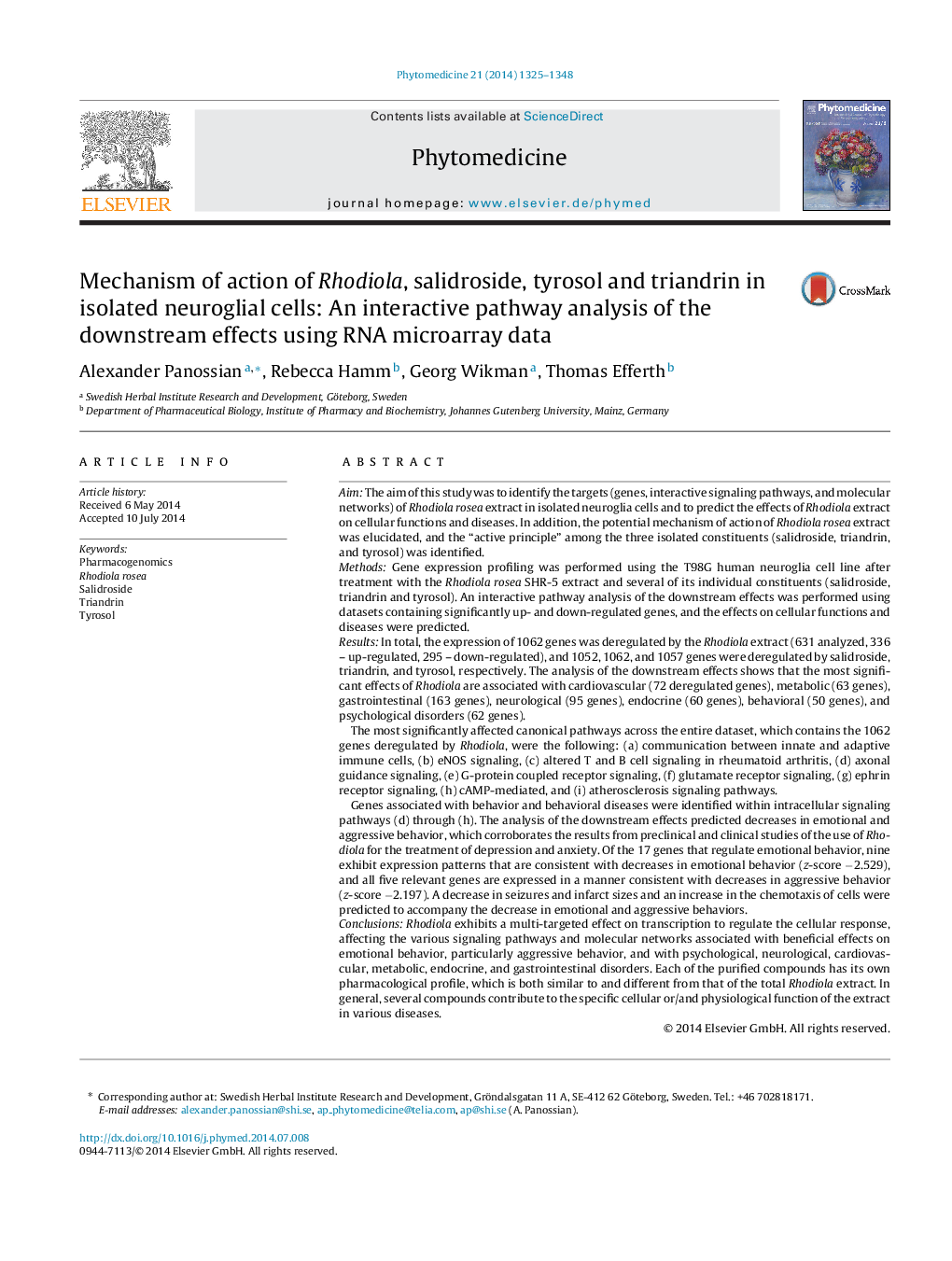| کد مقاله | کد نشریه | سال انتشار | مقاله انگلیسی | نسخه تمام متن |
|---|---|---|---|---|
| 5816607 | 1116147 | 2017 | 24 صفحه PDF | دانلود رایگان |
عنوان انگلیسی مقاله ISI
Mechanism of action of Rhodiola, salidroside, tyrosol and triandrin in isolated neuroglial cells: An interactive pathway analysis of the downstream effects using RNA microarray data
دانلود مقاله + سفارش ترجمه
دانلود مقاله ISI انگلیسی
رایگان برای ایرانیان
کلمات کلیدی
موضوعات مرتبط
علوم زیستی و بیوفناوری
بیوشیمی، ژنتیک و زیست شناسی مولکولی
بیوشیمی بالینی
پیش نمایش صفحه اول مقاله

چکیده انگلیسی
AimThe aim of this study was to identify the targets (genes, interactive signaling pathways, and molecular networks) of Rhodiola rosea extract in isolated neuroglia cells and to predict the effects of Rhodiola extract on cellular functions and diseases. In addition, the potential mechanism of action of Rhodiola rosea extract was elucidated, and the “active principle” among the three isolated constituents (salidroside, triandrin, and tyrosol) was identified.MethodsGene expression profiling was performed using the T98G human neuroglia cell line after treatment with the Rhodiola rosea SHR-5 extract and several of its individual constituents (salidroside, triandrin and tyrosol). An interactive pathway analysis of the downstream effects was performed using datasets containing significantly up- and down-regulated genes, and the effects on cellular functions and diseases were predicted.ResultsIn total, the expression of 1062 genes was deregulated by the Rhodiola extract (631 analyzed, 336 - up-regulated, 295 - down-regulated), and 1052, 1062, and 1057 genes were deregulated by salidroside, triandrin, and tyrosol, respectively. The analysis of the downstream effects shows that the most significant effects of Rhodiola are associated with cardiovascular (72 deregulated genes), metabolic (63 genes), gastrointestinal (163 genes), neurological (95 genes), endocrine (60 genes), behavioral (50 genes), and psychological disorders (62 genes).The most significantly affected canonical pathways across the entire dataset, which contains the 1062 genes deregulated by Rhodiola, were the following: (a) communication between innate and adaptive immune cells, (b) eNOS signaling, (c) altered T and B cell signaling in rheumatoid arthritis, (d) axonal guidance signaling, (e) G-protein coupled receptor signaling, (f) glutamate receptor signaling, (g) ephrin receptor signaling, (h) cAMP-mediated, and (i) atherosclerosis signaling pathways.Genes associated with behavior and behavioral diseases were identified within intracellular signaling pathways (d) through (h). The analysis of the downstream effects predicted decreases in emotional and aggressive behavior, which corroborates the results from preclinical and clinical studies of the use of Rhodiola for the treatment of depression and anxiety. Of the 17 genes that regulate emotional behavior, nine exhibit expression patterns that are consistent with decreases in emotional behavior (z-score â2.529), and all five relevant genes are expressed in a manner consistent with decreases in aggressive behavior (z-score â2.197). A decrease in seizures and infarct sizes and an increase in the chemotaxis of cells were predicted to accompany the decrease in emotional and aggressive behaviors.ConclusionsRhodiola exhibits a multi-targeted effect on transcription to regulate the cellular response, affecting the various signaling pathways and molecular networks associated with beneficial effects on emotional behavior, particularly aggressive behavior, and with psychological, neurological, cardiovascular, metabolic, endocrine, and gastrointestinal disorders. Each of the purified compounds has its own pharmacological profile, which is both similar to and different from that of the total Rhodiola extract. In general, several compounds contribute to the specific cellular or/and physiological function of the extract in various diseases.
ناشر
Database: Elsevier - ScienceDirect (ساینس دایرکت)
Journal: Phytomedicine - Brought to you by:GAYATRI VIDYA PARISHAD COLLEGE OF ENGINEERING for Women Renewal due by 31 Dec 2017
Journal: Phytomedicine - Brought to you by:GAYATRI VIDYA PARISHAD COLLEGE OF ENGINEERING for Women Renewal due by 31 Dec 2017
نویسندگان
Alexander Panossian, Rebecca Hamm, Georg Wikman, Thomas Efferth,